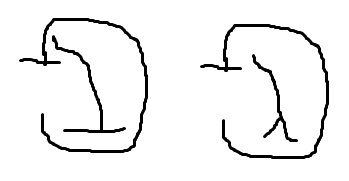I indicate when ideas aren’t mine or are partially mine.
Does the Torah begin with a Beit or a Reish?
The case of Beit:
“Why the Torah begins with the letter beit,” by Michael J. Alter.
https://www.amazon.com/dp/B00DJQAM5A/
Why the Torah Begins with the Letter Beit|Hardcover
The case of Reish, meaning the beit was put there and it was supposed to begin with the second letter the reish:
The King Follet Sermon, perhaps the last sermon Joseph Smith gave.
The King Follett Sermon
“I shall comment on the very first Hebrew word in the Bible; I will make a comment on the very first sentence of the history of creation in the Bible—Berosheit. I want to analyze the word. Baith—in, by, through, and everything else. Rosh—the head, Sheit—grammatical termination. When the inspired man wrote it, he did not put the baith there. An old Jew without any authority added the word; he thought it too bad to begin to talk about the head! It read first, “The head one of the Gods brought forth the Gods.” That is the true meaning of the words. Baurau signifies to bring forth. If you do not believe it, you do not believe the learned man of God. Learned men can teach you no more than what I have told you. Thus the head God brought forth the Gods in the grand council.”
The rest of this I did myself.
As we analyze each as the first letter, these images will help us:

The first image is a beit in a pei; the second is a reish in a pei; now let’s look at this.
The beit in a pei is like a tongue in a mouth. First, the beit pushes on the teeth, then the pei has the lips move in, the sequence in pronouncing beit. Also, in simple gematria, beit is the second letter in the Hebrew alphabet and pei is seventeen. 2*17=34. Every letter is a word and beit is beit-yud-tav, whose simple gematria is 2-10-22. 2+10+22=34. So the picture, the prime factorization, and the spelling of the letter are alike.
Now with the reish.
The tongue is sticking up and the reish touches the top of the mouth like when you pronounce it. Here, the pei is simply a mouth but the indentation might indicate the mouth is open, distinguishing between ‘M’ and ‘R’. Reish is resih-yud-shin or 20+10+21=51, and 51=3*17, where again 3 is reish and 17 is pei.
See you on the second night!
Does the Torah begin with a Beit or a Reish?
The case of Beit:
“Why the Torah begins with the letter beit,” by Michael J. Alter.
https://www.amazon.com/dp/B00DJQAM5A/
Why the Torah Begins with the Letter Beit|Hardcover
The case of Reish, meaning the beit was put there and it was supposed to begin with the second letter the reish:
The King Follet Sermon, perhaps the last sermon Joseph Smith gave.
The King Follett Sermon
“I shall comment on the very first Hebrew word in the Bible; I will make a comment on the very first sentence of the history of creation in the Bible—Berosheit. I want to analyze the word. Baith—in, by, through, and everything else. Rosh—the head, Sheit—grammatical termination. When the inspired man wrote it, he did not put the baith there. An old Jew without any authority added the word; he thought it too bad to begin to talk about the head! It read first, “The head one of the Gods brought forth the Gods.” That is the true meaning of the words. Baurau signifies to bring forth. If you do not believe it, you do not believe the learned man of God. Learned men can teach you no more than what I have told you. Thus the head God brought forth the Gods in the grand council.”
The rest of this I did myself.
As we analyze each as the first letter, these images will help us:

The first image is a beit in a pei; the second is a reish in a pei; now let’s look at this.
The beit in a pei is like a tongue in a mouth. First, the beit pushes on the teeth, then the pei has the lips move in, the sequence in pronouncing beit. Also, in simple gematria, beit is the second letter in the Hebrew alphabet and pei is seventeen. 2*17=34. Every letter is a word and beit is beit-yud-tav, whose simple gematria is 2-10-22. 2+10+22=34. So the picture, the prime factorization, and the spelling of the letter are alike.
Now with the reish.
The tongue is sticking up and the reish touches the top of the mouth like when you pronounce it. Here, the pei is simply a mouth but the indentation might indicate the mouth is open, distinguishing between ‘M’ and ‘R’. Reish is resih-yud-shin or 20+10+21=51, and 51=3*17, where again 3 is reish and 17 is pei.
See you on the second night!
